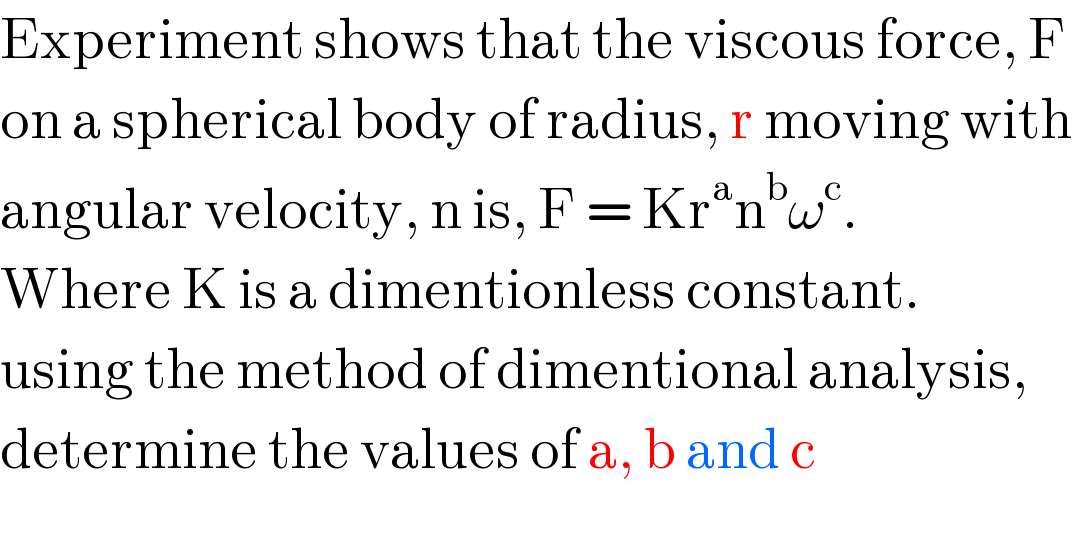
Question Number 9658 by tawakalitu last updated on 23/Dec/16

$$\mathrm{Experiment}\:\mathrm{shows}\:\mathrm{that}\:\mathrm{the}\:\mathrm{viscous}\:\mathrm{force},\:\mathrm{F} \\ $$$$\mathrm{on}\:\mathrm{a}\:\mathrm{spherical}\:\mathrm{body}\:\mathrm{of}\:\mathrm{radius},\:\mathrm{r}\:\mathrm{moving}\:\mathrm{with} \\ $$$$\mathrm{angular}\:\mathrm{velocity},\:\mathrm{n}\:\mathrm{is},\:\mathrm{F}\:=\:\mathrm{Kr}^{\mathrm{a}} \mathrm{n}^{\mathrm{b}} \omega^{\mathrm{c}} . \\ $$$$\mathrm{Where}\:\mathrm{K}\:\mathrm{is}\:\mathrm{a}\:\mathrm{dimentionless}\:\mathrm{constant}. \\ $$$$\mathrm{using}\:\mathrm{the}\:\mathrm{method}\:\mathrm{of}\:\mathrm{dimentional}\:\mathrm{analysis}, \\ $$$$\mathrm{determine}\:\mathrm{the}\:\mathrm{values}\:\mathrm{of}\:\mathrm{a},\:\mathrm{b}\:\mathrm{and}\:\mathrm{c} \\ $$
Commented by ridwan balatif last updated on 23/Dec/16

$$\mathrm{what}\:\mathrm{is}\:\omega\:\mathrm{in}\:\mathrm{that}\:\mathrm{question}? \\ $$$$\mathrm{is}\:\mathrm{that}\:\mathrm{a}\:\mathrm{mass}? \\ $$
Commented by ridwan balatif last updated on 23/Dec/16

$$\mathrm{r}\:\mathrm{is}\:\mathrm{radius}\:\left(\mathrm{m}\right) \\ $$$$\mathrm{n}\:\mathrm{is}\:\mathrm{angular}\:\mathrm{velocity}\left(\mathrm{rad}/\mathrm{s}\right) \\ $$$$\mathrm{what}\:\mathrm{is}\:\omega? \\ $$
Commented by sandy_suhendra last updated on 23/Dec/16
![I think that is F=Kr^a η^b v^c η=coefficient of viscosity (Pa s) r=radius of the ball (m) v=velocity of the ball (m/s) and [F]=[M][L][T]^(−2) [r]=[L] [η]=[M][L]^(−1) [T]^(−1) [v]=[L][T]^(−1) F=Kr^a η^b v^c [M][L][T]^(−2) =[L]^a {[M]^b [L]^(−b) [T]^(−b) }{[L]^c [T]^(−c) } [M][L][T]^(−2) =[M]^b [L]^(a−b+c) [T]^(−b−c) so b=1 −b−c=−2 ⇒ c=1 a−b+c=1 ⇒ a=1](Q9665.png)
$$\mathrm{I}\:\mathrm{think}\:\mathrm{that}\:\mathrm{is}\:\mathrm{F}=\mathrm{Kr}^{\mathrm{a}} \eta^{\mathrm{b}} \mathrm{v}^{\mathrm{c}} \\ $$$$\eta=\mathrm{coefficient}\:\mathrm{of}\:\mathrm{viscosity}\:\left(\mathrm{Pa}\:\mathrm{s}\right) \\ $$$$\mathrm{r}=\mathrm{radius}\:\mathrm{of}\:\mathrm{the}\:\mathrm{ball}\:\left(\mathrm{m}\right) \\ $$$$\mathrm{v}=\mathrm{velocity}\:\mathrm{of}\:\mathrm{the}\:\mathrm{ball}\:\left(\mathrm{m}/\mathrm{s}\right) \\ $$$$\mathrm{and}\:\left[\mathrm{F}\right]=\left[\mathrm{M}\right]\left[\mathrm{L}\right]\left[\mathrm{T}\right]^{−\mathrm{2}} \\ $$$$\:\:\:\:\:\:\:\:\:\left[\mathrm{r}\right]=\left[\mathrm{L}\right] \\ $$$$\:\:\:\:\:\:\:\:\:\left[\eta\right]=\left[\mathrm{M}\right]\left[\mathrm{L}\right]^{−\mathrm{1}} \left[\mathrm{T}\right]^{−\mathrm{1}} \\ $$$$\:\:\:\:\:\:\:\:\:\left[\mathrm{v}\right]=\left[\mathrm{L}\right]\left[\mathrm{T}\right]^{−\mathrm{1}} \\ $$$$ \\ $$$$\mathrm{F}=\mathrm{Kr}^{\mathrm{a}} \eta^{\mathrm{b}} \mathrm{v}^{\mathrm{c}} \\ $$$$\left[\mathrm{M}\right]\left[\mathrm{L}\right]\left[\mathrm{T}\right]^{−\mathrm{2}} =\left[\mathrm{L}\right]^{\mathrm{a}} \left\{\left[\mathrm{M}\right]^{\mathrm{b}} \left[\mathrm{L}\right]^{−\mathrm{b}} \left[\mathrm{T}\right]^{−\mathrm{b}} \right\}\left\{\left[\mathrm{L}\right]^{\mathrm{c}} \left[\mathrm{T}\right]^{−\mathrm{c}} \right\} \\ $$$$\left[\mathrm{M}\right]\left[\mathrm{L}\right]\left[\mathrm{T}\right]^{−\mathrm{2}} =\left[\mathrm{M}\right]^{\mathrm{b}} \left[\mathrm{L}\right]^{\mathrm{a}−\mathrm{b}+\mathrm{c}} \left[\mathrm{T}\right]^{−\mathrm{b}−\mathrm{c}} \\ $$$$\mathrm{so}\:\:\:\:\mathrm{b}=\mathrm{1} \\ $$$$\:\:\:\:\:\:\:−\mathrm{b}−\mathrm{c}=−\mathrm{2}\:\Rightarrow\:\mathrm{c}=\mathrm{1} \\ $$$$\:\:\:\:\:\:\:\:\mathrm{a}−\mathrm{b}+\mathrm{c}=\mathrm{1}\:\Rightarrow\:\mathrm{a}=\mathrm{1} \\ $$
Commented by ridwan balatif last updated on 23/Dec/16

$$\mathrm{now}\:\mathrm{i}\:\mathrm{understand} \\ $$
Commented by tawakalitu last updated on 23/Dec/16

$$\mathrm{i}\:\mathrm{really}\:\mathrm{appreciate}.\:\mathrm{God}\:\mathrm{bless}\:\mathrm{you}. \\ $$
Answered by ridwan balatif last updated on 23/Dec/16
![dimentional F=kgms^(−2) =[M][L][T]^(−2) r =m =[L] η =Pa.s=kgm^(−1) s^(−1) =[M][L]^(−1) [T]^(−1) ω =rad/s =[T]^(−1) F=k.r^a .η.^b ω^c [M][L][T]^(−2) =([L])^a ([M][L]^(−1) [T]^(−1) )^b ([T]^(−1) )^c [M][L][T]^(−2) =[M]^b [L]^(a−b) [T]^(−b−c) from dimentional [M] we get b=1 from dimentional [L] we get a−b=1 a−1=1 a=2 from dimentional [T] we get −b−c=−2 −1−c=−2 c=1 so, a=2 b=1 c=1 F=kr^2 ηω](Q9667.png)
$$\mathrm{dimentional} \\ $$$$\mathrm{F}=\mathrm{kgms}^{−\mathrm{2}} \\ $$$$\:\:\:\:=\left[\mathrm{M}\right]\left[\mathrm{L}\right]\left[\mathrm{T}\right]^{−\mathrm{2}} \\ $$$$\mathrm{r}\:\:=\mathrm{m} \\ $$$$\:\:\:\:\:=\left[\mathrm{L}\right] \\ $$$$\eta\:\:=\mathrm{Pa}.\mathrm{s}=\mathrm{kgm}^{−\mathrm{1}} \mathrm{s}^{−\mathrm{1}} \\ $$$$\:\:\:\:\:=\left[\mathrm{M}\right]\left[\mathrm{L}\right]^{−\mathrm{1}} \left[\mathrm{T}\right]^{−\mathrm{1}} \\ $$$$\omega\:=\mathrm{rad}/\mathrm{s} \\ $$$$\:\:\:\:\:=\left[\mathrm{T}\right]^{−\mathrm{1}} \\ $$$$\mathrm{F}=\mathrm{k}.\mathrm{r}^{\mathrm{a}} .\eta.^{\mathrm{b}} \omega^{\mathrm{c}} \\ $$$$\left[\mathrm{M}\right]\left[\mathrm{L}\right]\left[\mathrm{T}\right]^{−\mathrm{2}} =\left(\left[\mathrm{L}\right]\right)^{\mathrm{a}} \left(\left[\mathrm{M}\right]\left[\mathrm{L}\right]^{−\mathrm{1}} \left[\mathrm{T}\right]^{−\mathrm{1}} \right)^{\mathrm{b}} \left(\left[\mathrm{T}\right]^{−\mathrm{1}} \right)^{\mathrm{c}} \\ $$$$\left[\mathrm{M}\right]\left[\mathrm{L}\right]\left[\mathrm{T}\right]^{−\mathrm{2}} =\left[\mathrm{M}\right]^{\mathrm{b}} \left[\mathrm{L}\right]^{\mathrm{a}−\mathrm{b}} \left[\mathrm{T}\right]^{−\mathrm{b}−\mathrm{c}} \\ $$$$\mathrm{from}\:\mathrm{dimentional}\:\left[\mathrm{M}\right]\:\mathrm{we}\:\mathrm{get}\:\mathrm{b}=\mathrm{1} \\ $$$$\mathrm{from}\:\mathrm{dimentional}\:\left[\mathrm{L}\right]\:\mathrm{we}\:\mathrm{get}\:\mathrm{a}−\mathrm{b}=\mathrm{1} \\ $$$$\mathrm{a}−\mathrm{1}=\mathrm{1} \\ $$$$\mathrm{a}=\mathrm{2} \\ $$$$\mathrm{from}\:\mathrm{dimentional}\:\left[\mathrm{T}\right]\:\mathrm{we}\:\mathrm{get}\:−\mathrm{b}−\mathrm{c}=−\mathrm{2} \\ $$$$−\mathrm{1}−\mathrm{c}=−\mathrm{2} \\ $$$$\mathrm{c}=\mathrm{1} \\ $$$$\mathrm{so},\:\mathrm{a}=\mathrm{2}\:\mathrm{b}=\mathrm{1}\:\mathrm{c}=\mathrm{1} \\ $$$$\mathrm{F}=\mathrm{kr}^{\mathrm{2}} \eta\omega \\ $$
Commented by sandy_suhendra last updated on 23/Dec/16
![I think that is not ω (rad/s) but v=linear velocity (m/s) because the formula must be F=6πrηv and K=6π [Stokes′ Law]](Q9669.png)
$$\mathrm{I}\:\mathrm{think}\:\mathrm{that}\:\mathrm{is}\:\mathrm{not}\:\omega\:\left(\mathrm{rad}/\mathrm{s}\right)\:\mathrm{but}\:\mathrm{v}=\mathrm{linear}\:\mathrm{velocity}\:\left(\mathrm{m}/\mathrm{s}\right) \\ $$$$\mathrm{because}\:\mathrm{the}\:\mathrm{formula}\:\mathrm{must}\:\mathrm{be}\:\mathrm{F}=\mathrm{6}\pi\mathrm{r}\eta\mathrm{v} \\ $$$$\mathrm{and}\:\mathrm{K}=\mathrm{6}\pi\:\:\:\left[\mathrm{Stokes}'\:\mathrm{Law}\right] \\ $$
Commented by ridwan balatif last updated on 23/Dec/16

$$\mathrm{yeah},\:\mathrm{i}\:\mathrm{remember}\:\mathrm{now} \\ $$$$\mathrm{thank}\:\mathrm{you}\:\mathrm{sir} \\ $$
Commented by tawakalitu last updated on 23/Dec/16

$$\mathrm{i}\:\mathrm{really}\:\mathrm{appreciate},\:\mathrm{God}\:\mathrm{bless}\:\mathrm{you}. \\ $$
